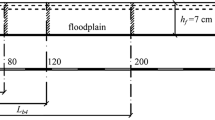Abstract
The occurrence of extreme weather events that lead to flooding are expected to worsen in frequency and intensity. During such extreme events with high water levels, bridges may be subjected to submerged orifice flow and overtopping because they were not designed for such large flows. As a result, bridges over the water course are vulnerable to unexpected excessive scour of the foundations and possible failure. This study presents the results of clear-water local scour and contraction scour experiments using full bridge geometry and river bathymetry and especially their separations from the total scour depth. Three bridge sites were selected for the physical model studies and constructed in a hydraulic laboratory that included upstream and downstream river reaches and bridge structure based on the Froude number similarity between field and laboratory. From observations, the experimental studies elucidated the interaction among the various types of scour, including long-term aggradation or degradation, vertical and/or lateral contraction scour, and local pier and abutment scour. This study proposes a method of separating each scour component from the total scour depth and qualitatively address the effect of vertical contraction to the average contraction scour.
Similar content being viewed by others
References
Arneson, L. A., Zevenbergen, L. W., Lagasse, P. E., and Clopper, P. E. (2012). Hydraulic Engineering Circular No. 18 (HEC-18): Evaluating scour at bridges Fifth Edition.
Dargahi, B. (1989). “Turbulent flow field around a circular cylinder.” Exp. in Fluids, Vol. 8, Nos. 1–2, pp. 1–12, DOI: 10.1007/BF00203058.
Ettema, R., Nakato, T., and Muste, M. (2010). “Estimation of scour depth at bridge abutments.” Final Report, NCHRP 24-20, Transportation Research Board, Washington, D.C.
Gotvald, A. J. and McCallum, B. E. (2010). Epic Flooding in Georgia.
Hong, S. (2005). Interaction of bridge contraction scour and pier scour in a laboratory river model, Master’s thesis, Georgia Institute of Technology, Atlanta, GA.
Hong, S., Gotvald, A., Sturm, T. W., and Landers, M. (2006). “Laboratory and field measurement of bridge contraction scour.” Proc., 3 rd Int. Conf. on Scour and Erosion, Gouda, Netherlands.
Hong, S. and Sturm, T. W. (2009). “Physical model study of bridge abutment and contraction scour under submerged orifice flow conditions.” Proc., 33rd IAHR Congress: Water Engineering for a Sustainable Environment, Vancouver, ASCE, Reston, VA.
Hong, S. and Sturm, T. W. (2010). “Physical modeling of abutment scour for overtopping, submerged orifice and free surface flows.” Proc., 5th Int. Conf. on Scour and Erosion, San-Francisco.
Hong, S. (2013). Prediction of clear-water abutment scour depth in compound channel for extreme hydrologic events, Ph.D. thesis, Georgia Institute of Technology, Atlanta, GA.
Hong, S. H, Sturm, T. W., and Stoesser, T. (2015). “Clear-water abutment scour depth in compound channel for extreme hydrologic events.” J. Hydraul. Eng., Vol. 141, No. 6, pp. 1–12, DOI: 10.1061/(ASCE) HY.1943-7900.0001002.
Hong, S. H and Abid, Irfan (2016). “Physical model study of bridge contraction scour.” KSCE J. Civil Eng., Vol. 20, No. 6, pp. 2578–2585, DOI: 10.1007/s12205-015-0417-x.
Landers, M. N. and Mueller, D. S. (1993). “Reference surfaces for bridge scour depths.” Proc., National Conference of Hydraulic Engineering, San Francisco, CA.
Lagasse, P. F., Clopper, P. E., Pagan-Ortiz, J. E., Zevenbergen, L. W., Arneson, L. A., Schall, J. D., and Girard, L. G. (2009). “Bridge scour and stream instability countermeasures.” Hydraulic Engineering Circular 23 (HEC-23), U.S. Federal Highway Administration, Washington, D.C.
Lee, S., Sturm, T.W., Gotvald, A., and Landers, M. (2004). “Comparison of laboratory and field measurements of bridge pier scour.” Proc., 2 nd Int. Conf. on Scour and Erosion, Singapore, pp. 231–239.
Lee, S. and Sturm, T. W. (2009). “Effect of sediment size scaling on physical modeling of bridge pier scour.” J. Hydraul. Eng., Vol. 135, No. 10, pp. 793–802, DOI: 10.1061/(ASCE)HY.1943-7900.0000091.
Melville, B. W. (1997). “Pier and abutment scour: integrated approach.” J. Hydraul. Eng., Vol. 123, No. 2, pp. 125–136, DOI: 10.1061/ (ASCE)0733-9429(1997)123:2(125).
Melville, B. W. and Coleman, S. E. (2000). Bridge scour, Water Resources Publications, Highlands Ranch, Colo.
Mueller, D. S. and Wagner, C. R. (2005). “Field observation and evaluations of streambed scour at bridges.” Rep. no. FHWA-RD-03-052, U.S. Federal Highway Administration, Washington, D.C.
Parola, A. C., Hagerty, D. J., and Kamojjala, S. (1998). Highway infrastructure damage caused by the 1993 upper Missippi River basin flooding, NCHRP report 417, Transportation Research Board, Washington, DC.
Raudkivi, A. J. (1986). “Functional trends of scour at bridge piers.” J. Hydraul. Eng., Vol. 112, No. 1, pp. 1–13, DOI: 10.1061/(ASCE)0733-9429(1986)112:1(1).
Richardson, E. V. and Davis, S. R. (2001). Evaluating scour at bridges, HEC-18, U.S. Federal Highway Administration, Washington, DC.
Stamey, Timothy C. (1996). Summary of Data-collection activities and effects of flooding from Tropical Storm Alberto in parts of Georgia, Alabama, and Florida, July 1994, U.S. Geological Survey Open-File Report 96-228, 23p.
Sturm, T. W. (2006). “Scour around bankline and setback abutments in compound channels.” J. Hydraul. Eng., Vol. 132, No. 1, pp. 21–32, DOI: 10.1061/(ASCE) 0733-9429(2006)132:1(21).
Sturm, T. W., Ettema, R., and Melville, B. M. (2011). “Evaluation of bridge-scour research: Abutment and contraction scour processes and prediction.” Rep. No. NCHRP P24-27, National Co-operative Highway Research Program, Washington, D.C.
Wardhana, K. and Hadipriono, F. C. (2003). “Analysis of recent bridge failures in the United States.” Journal of Performance of Constructed Facilities, Vol. 17, No. 3, pp. 144–150, DOI: 10.1061/(ASCE)0887-3828(2003)17:3(144).
Author information
Authors and Affiliations
Corresponding author
Rights and permissions
About this article
Cite this article
Hong, S.H., Lee, S.O. Insight of Bridge Scour during Extreme Hydrologic Events by Laboratory Model Studies. KSCE J Civ Eng 22, 2871–2879 (2018). https://doi.org/10.1007/s12205-017-0117-9
Received:
Accepted:
Published:
Issue Date:
DOI: https://doi.org/10.1007/s12205-017-0117-9




